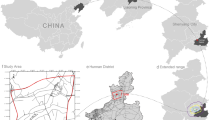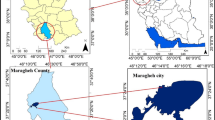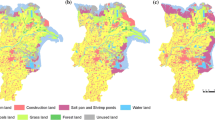Abstract
A-class scenic spot attracted a large number of tourists due to its natural scenery and cultural environment, which offers a place for people to participate in tourism and leisure activities. The competitiveness and growth plan of the A-level scenic spots are influenced by the characteristics of the distribution of tourist areas. As a result, many domestic scholars begin to study the spatial structure of tourist attractions and establish regional strategies based on the results of their studies. The planning plan for scenic spots is formulated by the government. In order to better support local economic and social growth and better serve the people, the government's development policy must better address the needs of the people. When formulating the plan, attention should be given to the local soil and water conservation situation. Monitoring the current situation of soil and water conservation will provide support for the potential growth of local soil and water conservation strategies. Landscape of the city is an essential feature of the city, and the landscape of the city is made up of land, water, and houses. The unique landscape of a city is often made up of the local natural environment, the social environment, and other facts.
















Similar content being viewed by others
Data and materials availability
The authors were not given permission to share the data.
Change history
22 November 2021
This article has been retracted. Please see the Retraction Notice for more detail: https://doi.org/10.1007/s12517-021-09042-7
28 September 2021
An Editorial Expression of Concern to this paper has been published: https://doi.org/10.1007/s12517-021-08472-7
References
Alkroosh I, Nikraz H (2012) Predicting axial capacity of driven piles in cohesive soils using intelligent computing. Eng Appl Artif Intell 25(3):618–627
Almahbobi S (2018) Experimental study of volume change and shear strength behaviour of statically compacted collapsible soil. Ph.D. Dissertation, Cardiff University
Al-Rawas AA (2000) State-of-the-art-review of collapsible soils. Sci Technol Rev 5:115–135
Anderson FJ (1968) Collapsing soils and their basic parameters in an area in the Tucson, Arizona vicinity, MSc Thesis, The University of Arizona
Ayadat T, Hanna A (2007) Prediction of collapse behaviour in soil. Eur J Environ Civ Eng 11(5):603–619
Barden L, McGown A, Collins K (1973) The collapse mechanism in partly saturated soil. Eng Geol 7(1):49–60
Basma AA, Tuncer ER (1992) Evaluation and control of collapsible soils. J Geotech Eng 118(10):1491–1504
Benchouk A, Abou-Bekr N, Taibi S (2013) Potential collapse for a clay soil. J Emerg Technol Adv Eng 3(10):43–47
Cheng ZL, Zhou WH, Garg A (2020) Genetic programming model for estimating soil suction in shallow soil layers in the vicinity of a tree. Eng Geol 268:105506
Choudhury C, Bharat TV (2015) Collapse behavior of clay soil under one-dimensional (1D) compression condition. 50th Indian Geotechnical Conference, Maharashtra, India
El Howayek A, Huang P T, Bisnett R, Santagata MC (2011) Identification and behavior of collapsible soils[R]. Purdue University. Joint Transportation Research Program
Esmaeili-choobar N, Esmaeili-falak M, Roohi-hir M, Keshtzad S (2013) Evaluation of collapsibility potential at Talesh, Iran[J]. EJGE, pp 2561–2573
Ferreira C (2001) Gene expression programming: a new adaptive algorithm for solving problems. Complex Syst 13(2):87–129
Gandomi AH, Alavi AH (2012) A new multi-gene genetic programming approach to non-linear system modeling. Part II: geotechnical and earthquake engineering problems. Neural Comput & Applic 21(1):189–201
Habibagahi G, Taherian M (2004) Prediction of collapse potential for compacted soils using artificial neural networks. Sci Iran 11(1&2):1–20
Hodek RJ, Lovell CW (1979) A new look at compaction process in fills. Bull Assoc Eng Geol 16(4):487–499
Houston SL, Houston WN (1997) Collapsible soils engineering. In: Houston SL (ed) Unsaturated soil engineering practice. ASCE, Reston, pp 199–232
Houston SL, Houston WN, Mahmoud HH (1995) Interpretation and comparison of collapse measurement techniques. In: Genesis and properties of collapsible soils. Springer, Dordrecht, pp 217–224
Houston SL, Houston WN, Zapata CE, Lawrence C (2001) Geotechnical engineering practice for collapsible soils. In Unsaturated soil concepts and their application in geotechnical practice. Springer, Dordrecht, pp 333–355
İnce İ, Bozdağ A, Fener M, Kahraman S (2019) Estimation of uniaxial compressive strength of pyroclastic rocks (Cappadocia, Turkey) by gene expression programming. Arab J Geosci 12(24):756
Jahed Armaghani D, Faradonbeh RS, Momeni E, Fahimifar A, Tahir MM (2018) Performance prediction of tunnel boring machine through developing a gene expression programming equation. Eng Comput 34(1):129–141
Javadi AA, Rezania M (2009) Intelligent finite element method: an evolutionary approach to constitutive modelling. Adv Eng Inform 23:442–451
Johari A, Nejad AH (2015) Prediction of soil-water characteristic curve using gene expression programming. Iran J Sci Technol 39(C1):143
Juang CH, Elton DJ (1997) Prediction of collapse potential of soil with neural networks. Transp Res Rec 1582:22–28
Khalili N, Geiser F, Blight G (2004) Effective stress in unsaturated soils: review with new evidence. Int J Geomech 4(2):115–126
Khuntia S (2014) Modelling of geotechnical problems using soft computing. Ph.D. Dissertation, National Institute of Technology, Rourkela
Lawton EC, Fragaszy RJ, James HH (1989) Collapse of compacted clayey sand. J Geotech Eng ASCE 155(9):1252–1267
Lawton EC, Fragaszy RJ, Hetherington MD (1992) Review of wetting-induced collapse in compacted soil. J Geotech Eng 118(9):1376–1394
Leong EC, Widiastuti S, Rahardjo H (2013) Estimating wetting-induced settlement of compacted soils using oedometer test. Geotech Eng 44(1):26–33
Li P, Vanapalli S, Li T (2016) Review of collapse triggering mechanism of collapsible soils due to wetting. J Rock Mech Geotech Eng 8(2):256–274
Lim YY, Miller GA (2004) Wetting-induced compression of compacted Oklahoma soils. J Geotech Geoenviron 130(10):1014–1023
Najemalden AM, Ibrahim SW, Ahmed MD (2020) Prediction of collapse potential for gypseous sandy soil using ANN technique. J Eng Sci Technol 15(2):1236–1253
Nazari A (2012) Prediction performance of PEM fuel cells by gene expression programming. Int J Hydrog Energy 37(24):18972–18980
Okonta FN (2012) Collapse settlement behavior of remoulded and undisturbed weathered quartzite. Int J Phys Sci 7(32):5239–5247
Pereira JH, Fredlund DG (2000) Volume change behavior of collapsible compacted Gneiss soil. J Geotech Geoenviron 126(10):859–946
Rabbi ATMZ, Cameron DA (2014) Prediction of collapse potential for silty glacial. Aust Geomech 49:65–78
Rabbi A, Cameron DA, Rahman MM (2014a) Effect of initial partial saturation on collapse behavior of glacial sand with fines[C]//Geo-Congress 2014: Geocharacterization and Modeling for Sustainability, pp 103–112
Rabbi A, Cameron DA, Rahman M M (2014b) Role of matric suction on wetting-induced collapse settlement of silty sand[J]. Unsaturated Soils: Research & Applications, pp 129–135
Sarıdemir M (2014) Effect of specimen size and shape on compressive strength of concrete containing fly ash: application of genetic programming for design. Mater Des 56:297–304
Sarıdemir M, Severcan MH (2016) The use of genetic programming and regression analysis for modeling the modulus of elasticity of NSC and HSC. Arab J Sci Eng 41(10):3959–3967
Schanz T, Karim HH (2018) Geotechnical characteristics of some Iraqi gypseous soils. In: MATEC Web of Conferences (vol 162, p 01005). EDP Sciences
Shahin MA (2013) Artificial intelligence in geotechnical engineering: applications, modeling aspects, and future directions[J]. Metaheuristics in water,geotechnical and transport engineering. Elsevier, pp 169–204
Shalaby SI (2017) Potential collapse for sandy compacted soil during inundation. Int J Innov Sci Eng Technol 4(5):307–314
Taskiran T (2010) Prediction of California bearing ratio (CBR) of fine grained soils by AI methods. Adv Eng Softw 41:886–892
Tenpe A, Patel A (2018) Application of genetic expression programming and artificial neural network for prediction of CBR. Road Mater Pavement 9(1):1–18
Acknowledgements
The authors thank the editor and anonymous reviewers for their helpful comments and valuable suggestions.
Funding
This work was supported by the Youth Fund Project of Humanities and Social Sciences Research of Ministry of Education (Grant No. 18YJC760117), the Doctoral Research Foundation of Anhui Jianzhu University (Grant No. 2020QDZ15), the Anhui Philosophy and Social Science Planning Project (Grant No. AHSKQ2019D097), the Special Project of Humanities and Social Sciences Research of Fuyang (Grant No. FYSK17-18ZD15), and the Innovation Training Program for College Students of Anhui Province (Grant No. S202010878086).
Author information
Authors and Affiliations
Contributions
Chun Ou and Xiamei Yao designed the research framework and wrote the manuscript, and Yuanyuan Chen was responsible for proofreading and optimization of the results.
Corresponding author
Ethics declarations
Competing interests
These no potential competing interests in our paper.
Additional information
Responsible Editor: Ahmed Farouk
This article is part of the Topical Collection on Big Data and Intelligent Computing Techniques in Geosciences
This article has been retracted. Please see the retraction notice for more detail: https://doi.org/10.1007/s12517-021-09042-7
About this article
Cite this article
Ou, C., Yao, X. & Chen, Y. RETRACTED ARTICLE: Landscape simulation of small towns along Huaihe River based on geographic information system and big data analysis. Arab J Geosci 14, 608 (2021). https://doi.org/10.1007/s12517-021-06693-4
Received:
Accepted:
Published:
DOI: https://doi.org/10.1007/s12517-021-06693-4




